BUICK CENTURY 1996 Owners Manual
Manufacturer: BUICK, Model Year: 1996, Model line: CENTURY, Model: BUICK CENTURY 1996Pages: 340, PDF Size: 17.61 MB
Page 201 of 340
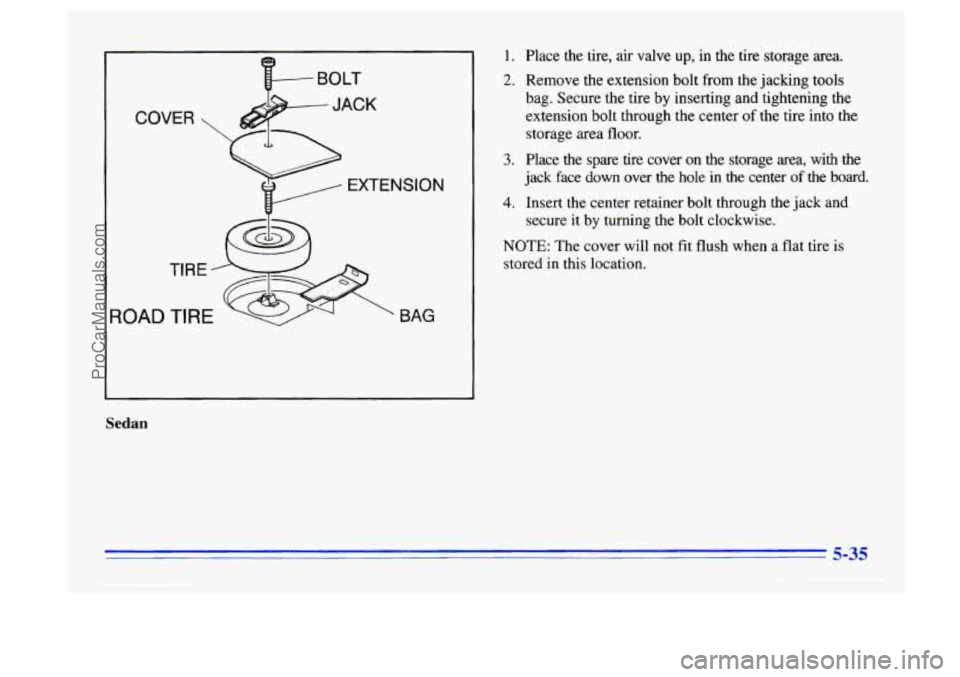
3OAD
TIRE .--
BAG
Sedan
1.
2.
3.
4.
Place the tire, air valve up, in the tire storage area.
Remove the extension bolt from the jacking tools
bag. Secure the tire by inserting and tightening the
extension bolt through the center
of the tire into the
storage area floor.
Place the spare tire cover on the storage area, with the
jack face down over
the hole in the center of the board.
Insert the center retainer bolt through the jack and
secure it
by turning the bolt clockwise.
NOTE: The cover will not
fit flush when a flat tire is
stored
in this location.
5-35
ProCarManuals.com
Page 202 of 340
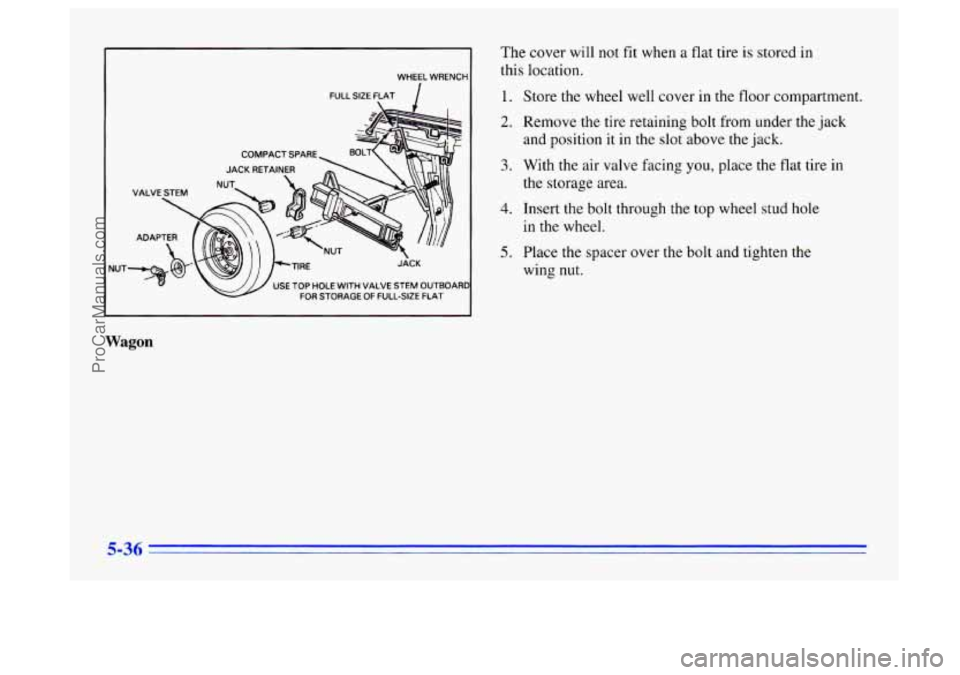
NUT
WHEEL WREN0
FULL SIZE FLAT /
COMPACT SPARE,
JACK RETAINER m \\!J JJ In-
JACK
USE TOP HOLE WITH VALVE STEM OUTBOARI:
FOR STORAGE OF FULL-SIZE FLAT
Wagon
The cover will not fit when a flat tire is stored in
this location.
1.
2.
3.
4.
5.
Store the wheel well cover in the floor compartment.
Remove the tire retaining bolt from under the jack
and position it in the slot above the jack.
With the air valve facing you, place the flat tire in
the storage area.
Insert the bolt through the top wheel stud hole
in the wheel.
Place the spacer over the bolt and tighten the
wing
nut.
5-36
ProCarManuals.com
Page 203 of 340
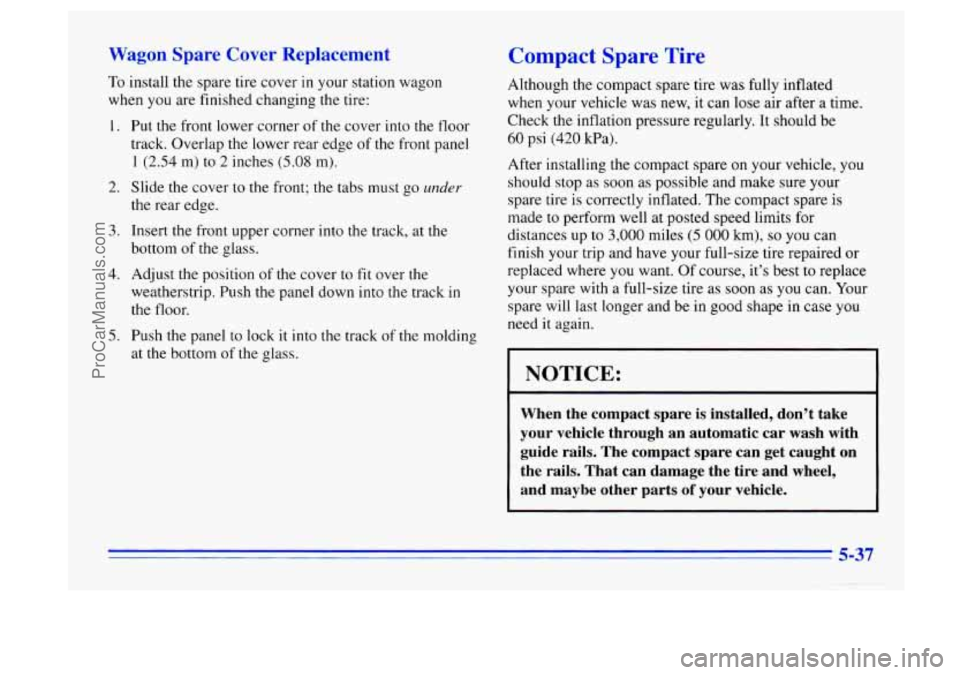
Wagon Spare Cover Replacement
To install the spare tire cover in your station wagon
when you are finished changing the tire:
1.
2.
3.
4.
5.
Put the front lower corner of the cover into the floor
track. Overlap the lower rear edge of the front panel
1 (2.54 m) to 2 inches (5.08 m).
Slide the cover to the front; the tabs must go under
the rear edge.
Insert the front upper corner into the track,
at the
bottom
of the glass.
Adjust the position
of the cover to fit over the
weatherstrip. Push the panel down into the track
in
the floor.
Push the panel
to lock it into the track of the molding
at the bottom of the glass.
Compact Spare Tire
Although the compact spare tire was fully inflated
when your vehicle was new, it can
lose air after a time.
Check the inflation pressure regularly. It should be
60 psi (420 kPa).
After installing the compact spare on your vehicle, you
should stop as soon as possible and make sure your
spare tire is correctly inflated. The compact spare is
made to perform well at posted speed limits for
distances up to
3,000 miles (5 000 km), so you can
finish your trip and have your full-size tire repaired or
replaced where
you want. Of course, it’s best to replace
your spare with a full-size tire as soon as you can. Your
spare will last longer and be in good shape in case
you
need it again.
NOTICE:
When the compact spare is installed, don’t take
your vehicle through an automatic car wash with
guide rails. The compact spare can get caught on
the rails. That can damage the tire and wheel,
and maybe other parts
of your vehicle.
5’ -7
ProCarManuals.com
Page 204 of 340
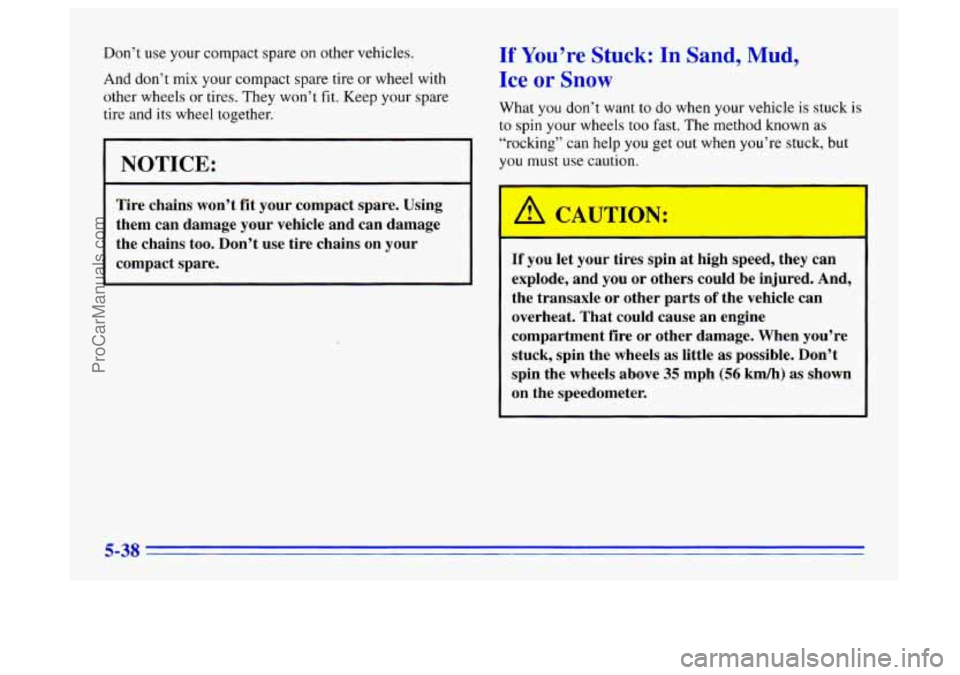
Don’t use your compact spare on other vehicles.
And don’t mix your compact spare tire or wheel with
other wheels or tires. They won’t fit. Keep your spare
tire and its wheel together.
I NOTICE:
Tire chains won’t fit your compact spare. Using
them can damage your vehicle
and can damage
the chains too. Don’t use tire chains on your
compact spare.
If You’re Stuck: In Sand, Mud,
Ice or
Snow
What you don’t want to do when your vehicle is stuck is
to spin your wheels too fast. The method known
as
“rocking” can help you get out when you’re stuck, but
you must use caution.
)N:
I- -
If you let your tires spin at high speed, they can
explode, and you or others could be injured. And,
the transaxle
or other parts of the vehicle can
overheat. That could cause an engine
compartment fire or other damage. When you’re
stuck, spin the wheels
as little as possible. Don’t
spin the wheels above
35 mph (56 km/h) as shown
on the speedometer.
ProCarManuals.com
Page 205 of 340
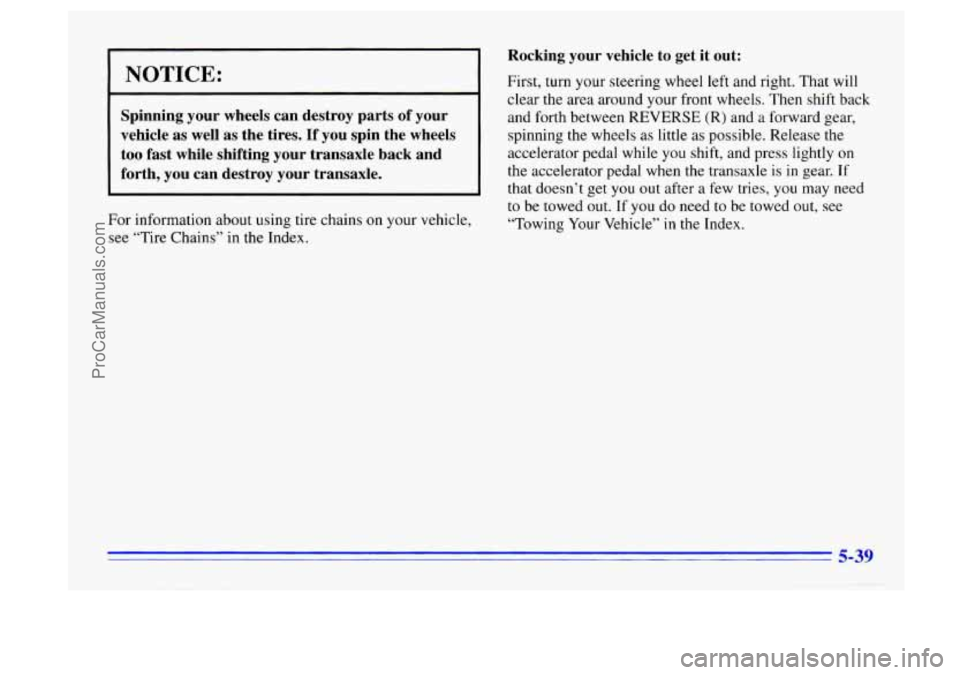
I NOTICE:
Spinning your wheels can destroy parts of your
vehicle
as well as the tires. If you spin the wheels
too fast while shifting your transaxle back and
forth, you can destroy your transaxle.
For information about using tire chains on your vehicle,
see “Tire Chains’’ in the Index.
Rocking your vehicle to get it out:
First, turn your steering wheel left and right. That will
clear
the area around your front wheels. Then shift back
and forth between REVERSE
(R) and a forward gear,
spinning the wheels
as little as possible. Release the
accelerator pedal while you shift, and press lightly
on
the accelerator pedal when the transaxle is in gear. If
that doesn’t get you
out after a few tries, you may need
to be towed out.
If you do need to be towed out, see
“Towing Your Vehicle” in the Index.
5-39
ProCarManuals.com
Page 206 of 340
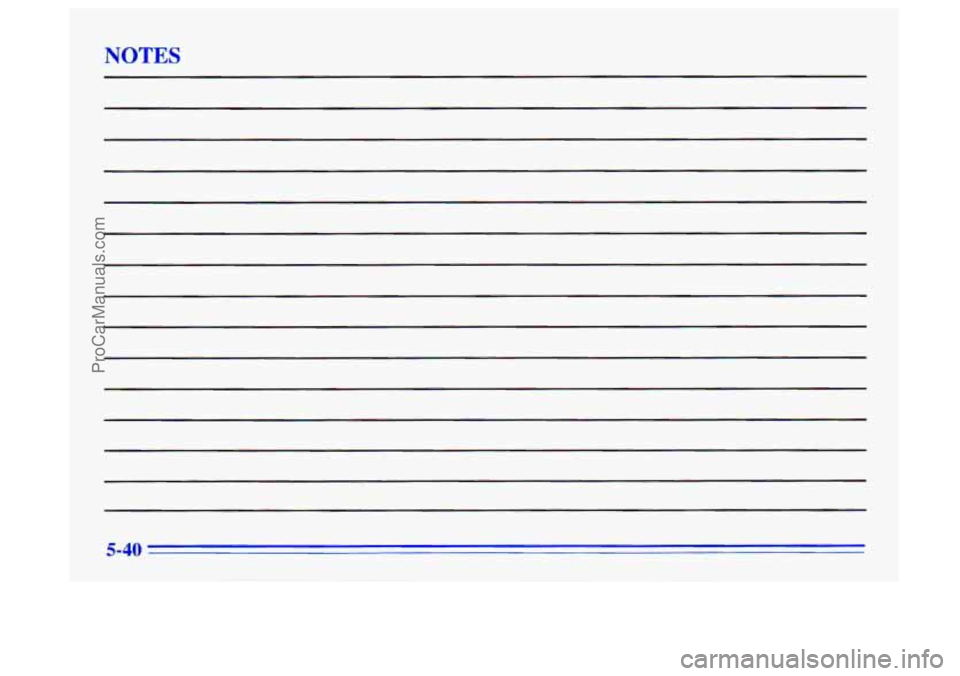
NOTES
ProCarManuals.com
Page 207 of 340
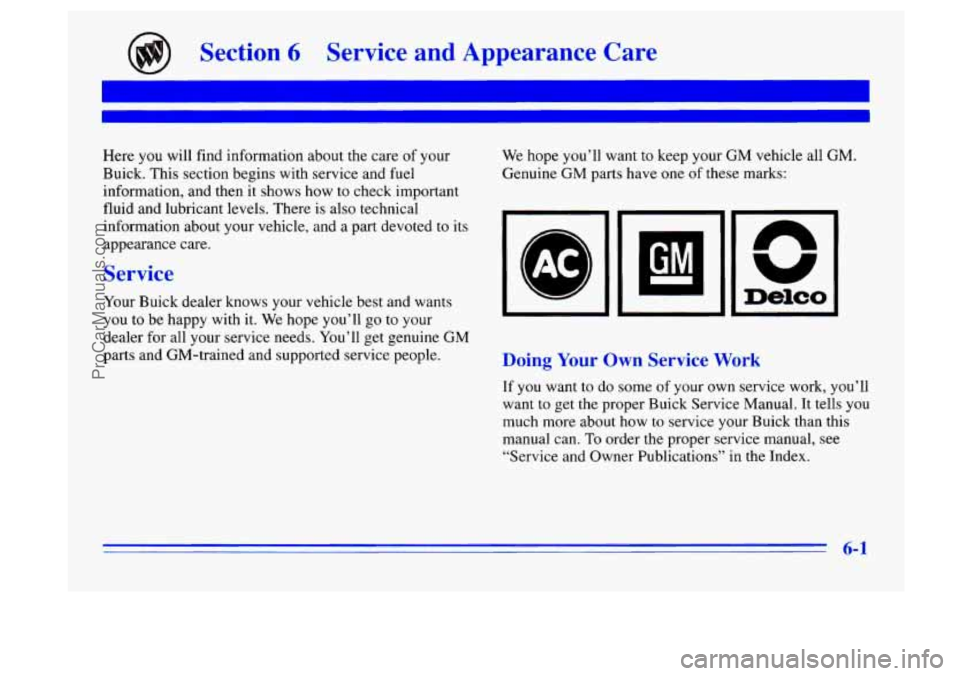
Section 6 Service and Appearance Care
Here you will find information about the care of your
Buick. This section begins with service and fuel
information, and then
it shows how to check important
fluid and lubricant levels. There is also technical
information about your vehicle, and a part devoted to
its
appearance care.
Service
Your Buick dealer knows your vehicle best and wants
you
to be happy with it. We hope you’ll go to your
dealer for all your service needs. You’ll get genuine
GM
parts and GM-trained and supported service people. We
hope you’ll want to keep your GM vehicle all GM.
Genuine GM parts have
one of these marks:
Doing Your Own Service Work
If you want to do some of your own service work, you’ll
want to get the proper Buick Service Manual. It tells you
much more about how to service your Buick than this
manual can.
To order the proper service manual, see
“Service and Owner Publications” in the Index.
6-1
ProCarManuals.com
Page 208 of 340
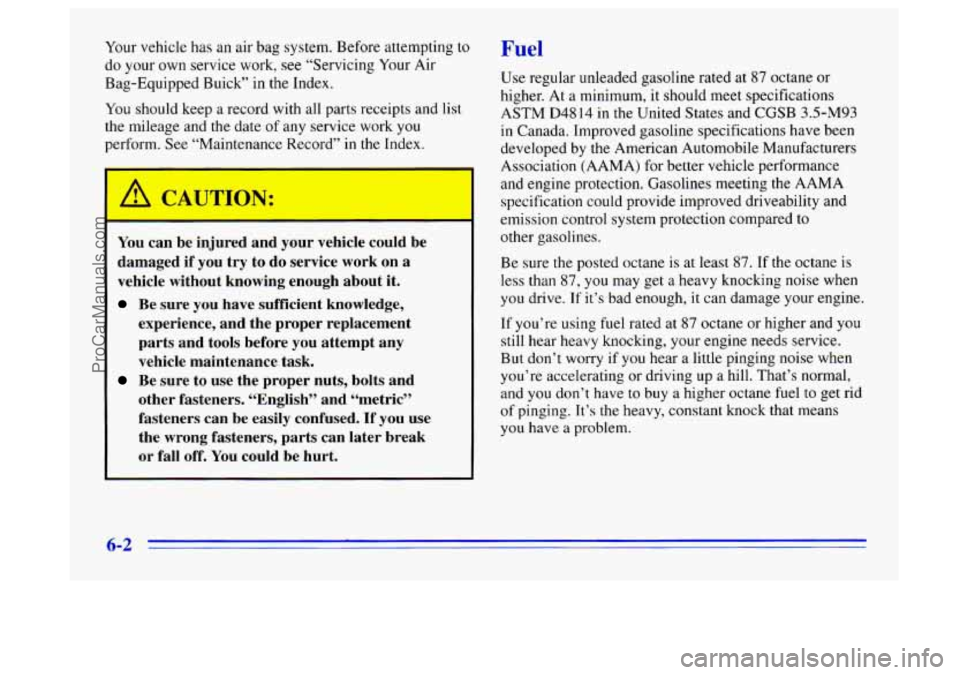
Your vehicle has an air bag system. Before attempting to
do your own service work, see “Servicing Your
Air
Bag-Equipped Buick” in the Index.
You should keep a record with all parts receipts and list
the mileage and the date
of any service work you
perform. See “Maintenance Record”
in the Index.
You
can be injured and your vehicle could be
damaged if
you try to do service work on a
vehicle without knowing enough about it.
Be sure you have sufficient knowledge,
experience, and the proper replacement
parts and tools before you attempt any
vehicle maintenance task.
Be sure to use the proper nuts, bolts and
other fasteners. “English” and “metric”
fasteners can be easily confused.
If you use
the wrong fasteners, parts can later break
or
fall off. You could be hurt.
Fuel
Use regular unleaded gasoline rated at 87 octane or
higher. At a minimum,
it should meet specifications
ASTM D48 14 in the United States and CGSB 3.5-M93
in Canada. Improved gasoline specifications have been
developed by the American Automobile Manufacturers
Association (AAMA) for better vehicle performance
and engine protection. Gasolines meeting
the AAMA
specification could provide improved driveability and
emission control system protection compared to
other gasolines.
Be sure
the posted octane is at least 87. If the octane is
less than
87, you may get a heavy knocking noise when
you drive.
If it’s bad enough, it can damage your engine.
If you’re using fuel rated at 87 octane or higher and you
still hear heavy knocking, your engine needs service.
But don’t worry if you hear
a little pinging noise when
you’re accelerating or driving up a
hill. That’s normal,
and you don’t have to buy a higher octane fuel
to get rid
of pinging. It’s the heavy, constant knock that means
you have a problem.
6-2
ProCarManuals.com
Page 209 of 340
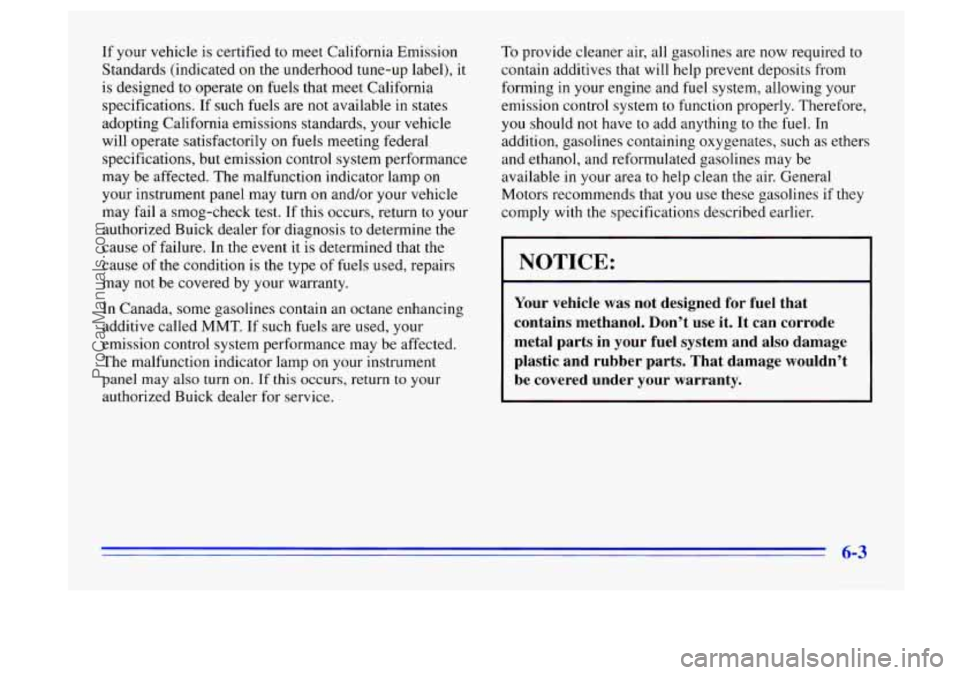
If your vehicle is certified to meet California Emission
Standards (indicated on the underhood tune-up label), it
is designed
to operate on fuels that meet California
specifications. If such fuels are not available
in states
adopting California emissions standards, your vehicle
will operate satisfactorily on fuels meeting federal
specifications, but emission control system performance
may be affected.
The malfunction indicator lamp on
your instrument panel may turn on and/or your vehicle
may fail
a smog-check test. If this occurs, return to your
authorized Buick dealer for diagnosis to determine the
cause of failure. In the event it is determined that the
cause of the condition is the type
of fuels used, repairs
may not be covered by your warranty.
In Canada, some gasolines contain an octane enhancing
additive called MMT.
If such fuels are used, your
emission control system performance may be affected.
The malfunction indicator lamp on your instrument
panel may also turn on. If this occurs, return to your
authorized Buick dealer for service.
To provide cleaner air, all gasolines are now required to
contain additives that will help prevent deposits from
forming
in your engine and fuel system, allowing your
emission control system to function properly. Therefore,
you should not have to add anything to the fuel. In
addition, gasolines containing oxygenates, such
as ethers
and ethanol, and reformulated gasolines may be
available
in your area to help clean the air. General
Motors recommends that you use these gasolines
if they
comply with the specifications described earlier.
I NOTICE:
Your vehicle was not designed for fuel that
contains methanol. Don’t use it. It can corrode
metal parts in your fuel system and also damage
plastic and rubber parts. That damage wouldn’t
be covered under your warranty.
6-3
ProCarManuals.com
Page 210 of 340
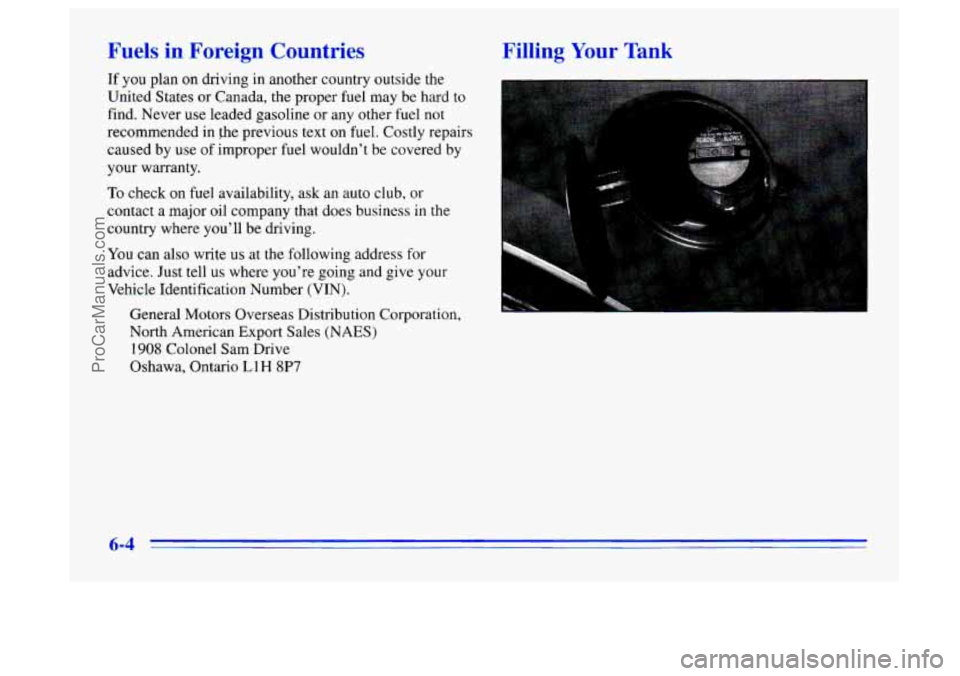
Fuels in Foreign Countries
If you plan on driving in another country outside the
United States or Canada, the proper fuel may be hard to
find. Never use leaded gasoline or any other fuel not
recommended in the previous text on fuel. Costly repairs
caused by use
of improper fuel wouldn’t be covered by
your warranty.
To check on fuel availability, ask an auto club, or
contact a major oil company that does business in the
country where you’ll be driving.
You can also write us at the following address for
advice. Just tell
us where you’re going and give your
Vehicle Identification Number (VIN).
General Motors Overseas Distribution Corporation,
North American Export Sales
(NAES)
1908 Colonel Sam Drive
Oshawa, Ontario
LlH 8P7
Filling Your Tank
6-4
ProCarManuals.com